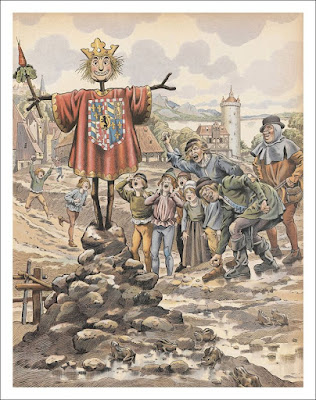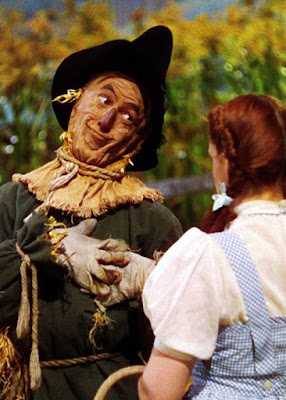Way before there were movies or tv shows made about them, their presence put me at unease. Truthfully, it shouldn't have. After all they were created as a protection to keep birds from eating crops. However, having grown up all, ancient Irish druid/pagan witch. In my mind, they represent poppets, and of course the wicker man. To me, they just aren't "right". Laugh all you wish, but I dare you to go into a field, or orchard at night, where one of these twisted effigies of a person hangs. Stay near it for a bit and then tell me it didn't, at the very least make you uncomfortable. Think about this darklings. "If scarecrows weren't so creepy, why are there so many movies, tv shows, books, and art dedicated to their darker side?"
 So, where did these sinister scarecrows get their start minions. There are conflicting historical facts about the actual when, where, and how, scarecrows actually began. I'll explain what I do know about these unholy straw creatures.
So, where did these sinister scarecrows get their start minions. There are conflicting historical facts about the actual when, where, and how, scarecrows actually began. I'll explain what I do know about these unholy straw creatures.
Some sources say they began around 2500 BCE in Greece, whilst others cite their existence prior to that in ancient Egypt. I'll begin with Egypt and continue with Greece, and also cover some interesting facts and lore from ancient Rome, Japan, and Europe.
The basis behind scarecrows is really quite simple. Birds, and even children would steal the farmers crops, the birds more-so than the urchins. The farmers couldn't logistically be guarding the crops 24/7, hence the concept of "scarecrows" ( to scare the crows) was born. In ancient Egypt there are two versions of this tale. The shortest of these legends is that the ancient Egyptians placed old tunics over reeds to resemble a human figure. They placed this "reed" human in their fields along the Nile river in order to frighten off any birds, or thieving little imps. The more elaborate version is that the farmers placed netting over the crops and used scarecrows to drive the birds into the nets. This allowed the farmers to not only save their crops, but they also trapped the birds in the netting, which the farmers would gather. Voila - birds for breakfast, lunch, and dinner. Either or both of these methods could be true, but we will never know.
The Greeks carved images of Priapus, the minor god of fertility and horticulture to scare the birds from the fields. Priapus was Aphrodite's son however, unlike his eternally beautiful mother was considered horribly ugly. In fact legend has it he was so ugly that whatever fields Priapus visited, birds avoided like the plague. So, being the crafty people that the Greeks were, they put two and two together. "Carved statues of Priapus equals no birds eating our crops." The interesting thing is, the statues of Priapus that still exist today, are not that of an ugly god. So my personal conclusion is, perhaps it's just enough to have some large human like figure "hanging around" as it were.
The Egyptians and Greeks were not the only ones to use scarecrows though. The Romans copied the idea of scarecrows, and as the Romans occupied various regions, particularly Europe and Britain they introduced their scarecrows to the locals.
Cultures and countries needn't had been introduced to scarecrows via the Greeks and Romans however. If you think about it, it just seems like a natural idea to come up with to solve a very real problem these farmers faced.
A perfect example of this is the 8th century Japanese. How do we know this? Well my darklings, because the Kojiki exists. The Kojiki is the oldest surviving Japanese book from 712 CE, that features a scarecrow named Kuebiko. Kuebiko is a god of agriculture and wisdom. It is said Kuebiko had knowledge of everthing in the world, but could not walk. The Kakashis (what the Japanese refer to scarecrows as) were created based on Kuebiko. Kakashi means " something stinky". These Kakashi were dressed in old smelly rags, straw hats with bells. These effigies were set on fire . The "stinky" smoke and effigy of their god kept the birds away.Our journey continues into Europe and Britain.
As I mentioned before the Romans introduced their form of scarecrow to what is now Northern Europe and England. (which also spread to Ireland). Britian in particular has a couple of very interesting legends. The British were a very superstitious lot, in particular their belief of a monstrous Boogeyman. It stands to reason then that if the Boogeyman is scary, then dressing up a straw man and sticking him in a field would scare the birds and the thieving little guttersnipes away. This second legend is more fact than legend. During the Middle Ages the black death aka the bubonic plague struck, killing between 30 and 60 percent of the worlds population. That included children. Children where used to frighten birds away from crops by striking stones together. No children, no noise. Hence, scarecrows were employed to take the place of the deceased children.As the years, decades, and centuries rolled on, scarecrows were still in use all over the world believe it or not. Though in the 21st century other means to keep birds from crops are being utilized. You will find scarecrows in more rural areas, and in family gardens. Scarecrows by and large have morphed into a symbol of Autumn aka Fall. They can be seen decorating homes, businesses, even churches, and farms who have shops to sell their wares. Scarecrows aren't "scary" at all, and are mostly smiley, cute, plaid wearing straw effigies, that couldn't frighten a mouse. I suspect that this version of scarecrow came about thanks to The Wonderful Wizard of Oz books, but particularly the 1939 legendary movie The Wizard of Oz.
As film making progressed, so to did the imagining of the scarecrow. A once benevolent ally, turned into a murderous monster. If you think about it, technically the murdering monster would be a more accurate description of it's original purpose. There are now many such movies, television show episodes, books, stories, and games with the scarecrow either as the supernatural villain, or being controlled by a human, or other supernatural villain. I myself have only watched less than a handful of said shows, and read only one book that included a scarecrow in it's pages. The first is from the television series Friday The 13th season one (that's the one with cursed objects not Jason) called Scarecrow. He and Louise Robey were excellent in this episode as they are in all of the episodes they appear in. The next television series R.L Stine's The Haunting Hour, also employs a scarecrow as the horror to be feared. The long running television series Supernatural also had a pretty sinister scarecrow in season one, except this one lived in an orchard.
Lets get started with season 1 episode 11 of Friday the 13th Scarecrow.Friday the 13th follows the exploits of Micki Foster and Ryan Dallion, owners of an antiques store filled with cursed objects. This episode was directed by Timothy Bond and written by Peter Lauterman, who expertly crafted a gripping narrative that keeps viewers on the edge of their seats.
Micki Foster (played by Louise Robey): is a resourceful and determined woman who, along with Ryan, is tasked with retrieving the cursed objects they once sold. In "Scarecrow," Micki's strength and resilience are put to the test as she tries to survive the scarecrow.
- Ryan Dallion (played by John D. LeMay): Micki's cousin and now co-owner of Curious Goods, joins Micki in the quest to recover the cursed objects. In "Scarecrow," Ryan's courage is tested as he confronts the terrifying scarecrow, whilst trying to save Micki.
- Jack Marshak (played by Chris Wiggins): is a wise and enigmatic occult expert, who was once friends with "uncle louis, who acts as a mentor to Micki and Ryan. In "Scarecrow," Jack assists them in unraveling the mysteries surrounding the scarecrow's origins and powers.
R.L. Stine's The Haunting Hour is a chilling anthology series based on the works of renowned author R.L. Stine. In the episode "Scarecrow" from Season 2, viewers are drawn into a world where scarecrows are more than just benign farm decorations.
Sarah: Played by Britt Irvin
Tommy: Played by Joel Courtney
Jake: Played by Jacob Tremblay
In "Scarecrow" Sarah, Tommy, and Jake find themselves stranded in a small town where scarecrows mysteriously come to life. As night falls, the scarecrows become more menacing, terrorizing anyone who crosses their path. The trio must unravel the town's dark secret and find a way to escape the clutches of the malevolent scarecrows before it's too late.
Let me tell you something darklings , Be warned, although this series and episode are a spin off R.L, Stine's Goosebumps, it was made for older "kids" and this episode - again named "scarecrow" is not kid friendly. There are two endings to this episode with one being much more grim than the other. Make no mistake though, this episode is sinister.
Supernatural is a long-running supernatural drama series that follows the adventures of two brothers, Sam and Dean Winchester, as they battle supernatural creatures. In the episode "Scarecrow," the brothers encounter a twisted tradition involving a malevolent scarecrow.
Friday the 13th The Series S01E11 " Scarecrow "
Friday the 13th The Series S01E11 " Scarecrow "R.L. Stine The Haunting Hour S02E11 "Scarecrow"
Supernatural S01E11 "Scarecrow"










Comments
Post a Comment